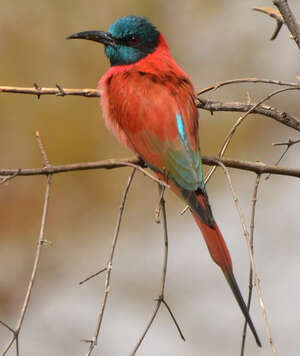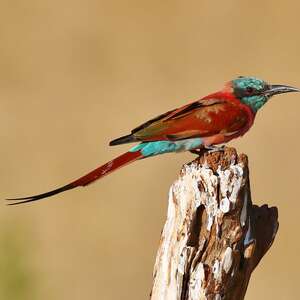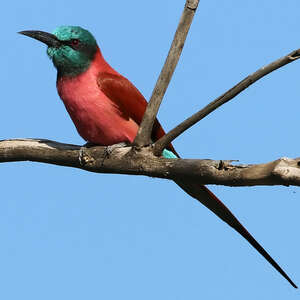Northern Carmine Bee-eater
Merops nubicus - Guêpier écarlate
Identification
Before 2000, the Northern Carmine Bee-eater was split into two subspecies. Morphological and biological differences were so rare, if not nonexistent, that now the species is monotypic. There is no sexual dimorphism between male and female, except that the tail streamers are slightly shorter in the female. The Northern Carmine Bee-eater is a large bee-eater with a long tail, the streamers corresponding to the two middle rectrices can reach up to 12 cm long. Vividly colored in scarlet and crimson, it is a delight to its observers and cannot be confused with another bee-eater. An untrained eye could possibly confuse it with the Carmine Bee-eater, but its range remains different. Only a few vagrant Carmine Bee-eaters, which remain rare, can meet our species in South Sudan. The Anglo-Saxons have also correctly separated these two species as Northern and Southern. Perched, the Northern Carmine Bee-eater has its head completely beryl green or blue back-to-light, which gradually becomes tinged with dark olive-turquoise at the level of the nape and throat. A thin black mask, rather thin around the lores, widens until the auricular covers. It stops precisely at the boundary of the head's blue. In profile this boundary forms a half crescent. The beak is black, slightly curved, long and massive, wide at its base and pointed at the tip. The iris is blood red or brown-red and the legs brownish black. The nape, mantle, chest and belly are pink-carmine. The scapulae are scarlet, the tertiaries are bluish green and the primaries and secondaries are brown with light dark blue edges. The back, rump and upper tail are pale sky blue. The rectrices are scarlet with blackish streamers.In flight and viewed from below, the wings are fawn, the tail is gray, the under-tail feathers are light blue and the chest is pink. When spread out, the tail takes the shape of an extended fan with two central streamers. On juveniles, dark spots are visible on the forehead and crown. The nape and upper mantle are brownish earthy and the lower part is red. The chin and throat feathers are dark gray, bordered in blue. The chest is pale pink, spotted with fawn, and the belly is very pale pink. The undertail feathers are pale grayish blue. The scapulars and tertiaries are light olive brown, bordered in blue. The rump is blue-gray. The wings and tail are mat scarlet, tinged with brown. The coverts are edged in pink. The rectrices are edged in greenish and it does not possess central streamers.
Subspecific information monotypic species
Foreign names
- Guêpier écarlate,
- Abejaruco carmesí norteño,
- abelharuco-carmim,
- Scharlachspint,
- kármin gyurgyalag,
- Noordelijke Karmijnrode Bijeneter,
- Gruccione carminio settentrionale,
- nordlig karminbiätare,
- Karminbieter,
- včelárik červený,
- vlha núbijská,
- Bee-eater Karminbiæder,
- punamehiläissyöjä,
- abellerol escarlata septentrional,
- żołna szkarłatna,
- rdeči čebelar,
- Нубийская щурка,
- キタベニハチクイ,
- 红蜂虎,
- nordlig karminbiätare,
- 北方洋紅蜂虎,
Voice song and call
The voice of the Northern Carmine Bee-eater is typical of the species and differs from that of other bee-eaters. The flight call is a short and deep sound klunk, tchoung, tunk or terk. It can be guttural and sometimes slightly rolled krrunk. Other strong and staccato sounds, always in flight and with six notes are usually doubled, sometimes repeated up to 6 times but this is much rarer: Rik rik rik rak rak rik rak rik The alarm call is shrill tirrik tirrik tirrik.
Habitat
The habitat of the Northern Carmine Bee-eater can be located in both dry and wet areas. It consists of wooded savannas or dotted with shrubs, arid grassy plains and dry acacia steppes, fields and forests, floodplains with slow rivers forming meanders amongst other features, lake shores and mangroves. Its altitudinal limit is between 1,000 and 1,500 meters.
Behaviour character trait
The Northern Carmine Bee-eater is a gregarious species that can migrate seasonally over short distances, up to 650 km, when nesting.
This is a North-South migration between the breeding season and the winter. Additionally, while some individuals are sedentary and nest at low altitudes, others migrate to heights of up to 1,500 metres. They nest along high sand cliffs, preferably devoid of vegetation, situated along meandering rivers. The Northern Carmine Bee-eater hunts above wet or arid habitats depending on its distribution. It is quickly attracted to the smoke of bushfires, hunting near the flames for the fleeing insects. In Manding languages, it is nicknamed the cousin of fire. It also takes advantage of the presence of wild or domesticated mammals, large terrestrial birds and even the movements of people on foot or vehicle to easily find food. Finally, some colonies also migrate to hunt, especially when they feed on bees and follow the migration of crickets.Flight
Dietfeeding habits
The Northern Carmine Bee-eater is an insectivore. It feeds on Orthoptera (grasshoppers, crickets), Hymenoptera (bees, ants), Hemiptera (cicadas), butterflies, dragonflies and termites.
It hunts by ambush from a fixed and clear post, this can be a tree with dead branches, fence posts, or from the back of a large mammal. Large prey such as bees are hunted by ambush. The Northern Carmine Bee-eater then returns to its perch to remove the sting and thus avoid being stung. Prey is thrown into the air in order to place it correctly in the beak and swallowed. Small insects are hunted directly in flight.Reproduction nesting
The Northern Carmine Bee-eater nests along rivers. In the north of its range its nesting range extends horizontally from the Senegal River to Eritrea, with eggs being laid between February and June. In the south, the nesting limit runs through Gambia, northern Ghana, central Nigeria, northern Democratic Republic of Congo to northern Kenya and the rivers Juba and Chebeli in Somalia, with egg-laying taking place from September to October. The nesting sites are not fixed and vary over the years as old sandy walls collapse and new ones form. If the site is not destroyed, the colony can return to the same spot for several years.
Otherwise, the colony will settle in 4 to 5 months before nesting. The Northern Carmine Bee-eater nests in dense large colonies. A nesting site usually gathers between 100 and 1,000 nests but occasionally up to 10,000. The density, on average, is around 60 holes per square metre. During this period the colonies become very noisy and male offering to the females are common. As mentioned a few lines higher, the nest is located in sandy walls but can also be dug directly into a flat ground. The gallery, more or less rectilinear and horizontal, measures between 1 and 2 metres and is 6 cm in diameter, ending in an oval incubation chamber. The female will lay 2 or 3 eggs if the pair nests at low altitude and 3 to 5 eggs at altitude. Incubation is provided by both parents and they feed the chicks together who will leave the nest 23 to 30 days after hatching. Nests that are occupied soon become carpeted with pellets of excrement containing insect debris and trodden, releasing a strong smell of ammonia.Geographic range
Threats - protection
Sources of information
- IOC World Bird List (v15.1), Gill, F and D Donsker (Eds). 2025-12-07.
- Martins-pêcheurs, martins-chasseurs, guêpiers et rolliers, Hilary Fry et Kathie Fry
- eBird, Cornell Lab of Ornithology et National Audubon Society
Other sources of interest
 Specification sheet created on
16/07/2023 by Nathalie Santa Maria
Specification sheet created on
16/07/2023 by Nathalie Santa MariaTranslation by AI Oiseaux.net
© 1996-2025 Oiseaux.net
- Accipitriformes
- Aegotheliformes
- Anseriformes
- Apodiformes
- Apterygiformes
- Bucerotiformes
- Caprimulgiformes
- Cariamiformes
- Casuariiformes
- Charadriiformes
- Ciconiiformes
- Coliiformes
- Columbiformes
- Coraciiformes
- Cuculiformes
- Eurypygiformes
- Falconiformes
- Galliformes
- Gaviiformes
- Gruiformes
- Leptosomiformes
- Mesitornithiformes
- Musophagiformes
- Nyctibiiformes
- Opisthocomiformes
- Otidiformes
- Passeriformes
- Pelecaniformes
- Phaethontiformes
- Phoenicopteriformes
- Piciformes
- Podargiformes
- Podicipediformes
- Procellariiformes
- Psittaciformes
- Pterocliformes
- Rheiformes
- Sphenisciformes
- Steatornithiformes
- Strigiformes
- Struthioniformes
- Suliformes
- Tinamiformes
- Trogoniformes

































